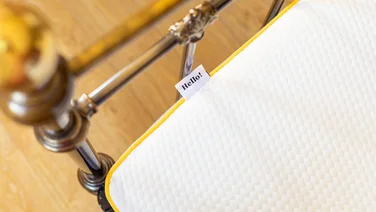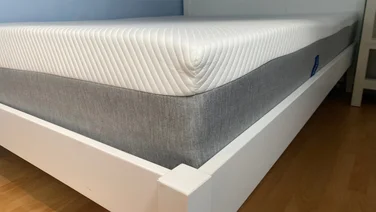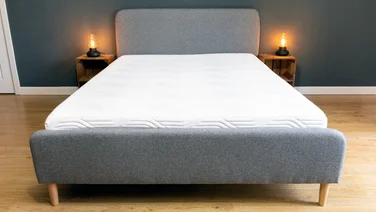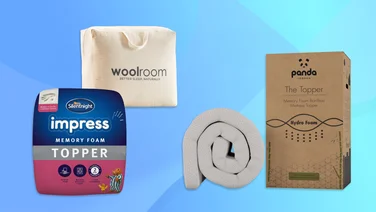To help us provide you with free impartial advice, we may earn a commission if you buy through links on our site. Learn more

If you’ve bought a new mattress, topper or pillow in recent years, there’s a good chance it contains memory foam. But how much do you really know about the this world-conquering material?
This guide is here to tell you everything you need to know about memory foam, from how it’s made and what it’s made from, to its pros and cons when used as a material in some of the most popular mattresses on the market. So, after reading this, you’ll be able to sleep a little easier.
READ NEXT: Best single mattress
What is memory foam?
Memory foam is a material used to make products that mould comfortably to the shape of a person’s body. It is also known by the technical terms ‘viscoelastic polyurethane foam’ and ‘low-resistance polyurethane foam’ (LRPu).
As with most types of polyurethane, memory foam is produced through the chemical reaction of compounds called polyols and isocyanates. However, unlike other, more basic flexible polyurethane foams (FPF) – such as the foam often used as a base layer in mattresses – memory foam contains additional chemicals that increase its density and viscosity.
Famously, memory foam is used in mattresses from brands like Tempur, Eve and Simba. But the material is also used in pillows, as well as in orthopaedic shoes, wheelchair seat pads and even in the ear cushions of high-end headphones. Here are some of our favourite memory foam products:
Panda Memory Foam Bamboo mattress topper | Check prices at Panda
Tempur Cloud Pillow | Check price at Amazon
Nectar Memory Foam mattress | Check prices at Nectar
Eve Original | Check prices at Eve
What makes memory foam comfortable?
On a basic level, memory foam is comfortable because it can compress, and it can compress because it’s foam with a solid, sponge-like structure formed around innumerable tiny pockets of air. When the material is depressed, the air is squeezed out and those pockets give up their space for the solid structure of the foam to move into.However, memory foam has two key properties that contribute to the long-term comfort for the user: its viscosity and its elasticity. Hence the term ‘viscoelastic polyurethane foam’.
When people think of viscosity, they tend to think of fluids, particularly thick, gluey fluids, and how they ooze or flow. When it comes to memory foam, viscosity refers to how the foam changes shape, and how it at least partially resists that change, under pressure. If memory foam wasn’t viscous, it wouldn’t be able to mould to the body as it does.
Meanwhile, the elasticity of memory foam allows it to return to its original shape after use. If you’re already the owner of a memory foam mattress, then you may have noticed a decline in the material’s elasticity over the years – it doesn’t quite bounce back to its original, plump form as it used to. This tends to occur due to the accumulation of small deformations in the foam resulting from load or exposure to high temperatures.
It’s the combination of these two properties – elasticity and viscosity – that enables memory foam to provide a comfortable, supportive contact for the human body throughout intensive, long-term use.
READ NEXT: Best memory foam mattress topper
What are the benefits of memory foam in a mattress?
The unique properties of memory foam enable it to add some much-celebrated benefits to mattresses and other products.

First, and foremost, many people – this article’s author included – find memory foam very comfortable to lie upon. Key to the material’s comfort is its effectiveness at relieving the burden on pressure points throughout the body. These are the parts most in need of support – whether that’s the hips, the limbs or wherever else – requiring the memory foam, through a combination of pressure and body heat, to yield and bring the body into alignment. Users often report a lessening of aches and pain, even improvements in health conditions, following extended use of a memory foam mattress.
More simply, many users say they enjoy the feel of memory foam, which is soft, squishy and free from the peaks and troughs sometimes found in sprung mattresses.
Another benefit of memory foam mattresses is that most are relatively lightweight. The more traditional pocket-sprung mattress, with its hundreds or even thousands of metal springs, tends to be far heavier, and therefore harder to carry and turn.
A memory foam pillow has similar benefits to a memory foam mattress but, of course, those benefits are focused on the neck. Memory foam can also be found in some mattress toppers, delivering comfort and pressure relief without requiring the purchase of a whole new mattress.
READ NEXT: Best mattress for heavy people
How memory foam is made
Many companies around the world make their own memory foam products, and the exact manufacturing process can vary depending on the specifications of the product. That said, the manufacture of memory foam usually includes three basic steps:
- Chemicals including isocyanates and polyols are mixed and poured into a mould, usually mattress- or pillow-shaped, though a variety of mould profiles can be used to create specific design features, such as textured surfaces.
- The foam is allowed to cool and set. The set foam is lifted from the mould, and any excess material is removed. (As an alternative to moulds, the setting foam can be rolled out into large blocks on a conveyor belt, ready for cutting and processing.)
- The completed memory foam piece is incorporated into a product. This can be simple, as in the case of a pillow composed entirely of memory foam, or more complicated, as in the case of a hybrid mattress, where the memory foam must be integrated with coils or springs, as well as other foams.
Some brands have created (or adopted) their own proprietary versions of memory foam, purported to offer unique benefits to the user. For instance, the open-cell foams that can be found in Emma mattresses claim to improve breathability, airflow and temperature regulation.
What are the drawbacks to memory foam – and can it kill you?
Viscoelastic polyurethane foam – the classic memory foam material – contains chemicals that can be toxic to humans, such as benzene and naphthalene. So discussions about the composition of memory foams can be alarming. Just listen to the episode of Darin Olien’s podcast titled ‘Fatal Conveniences: Memory Foam’, if you want to be put off memory foam mattresses for life.
However, lots of everyday things contain toxins, from apples which contain cyanide to watercolour paint which contains paraformaldehyde. The real question is: can the potentially harmful chemicals in memory foam enter the body in a way that damages our health?

One process whereby chemicals from memory foam may be consumed is through ‘off-gassing’, which is the release of airborne chemicals – known as volatile organic compounds, or ‘VOCs’ – in a vapour. In mattresses, the majority of off-gassing tends to occur in the hours or days after the mattress is removed from the packaging. It’s what gives rise to that “new mattress smell”.
For most people, the amount of off-gassing that occurs with a new mattress seems to be harmless, and the most dangerous chemicals do not appear to be present in any significant quantities. In the words of The Sleep Foundation, “off-gassing odours pose no known serious health risks, but they can be unpleasant”. With that in mind, if you are highly sensitive to odours, or if you have allergies or are asthmatic, then it might be wise to choose a memory foam product that’s certified for a low level of VOC off-gassing.
The prevailing view remains that memory foam is safe when used normally. Most manufacturers and consumers subscribe to this belief, and the global memory foam market is forecast to grow by 4.5% per year between now and 2030.
| Memory foam alternatives: pros, cons and example mattresses | |||
| Material | Pros | Cons | Example mattresses |
| Latex |
|
|
Dunlopillo Millennium |
| Gel foam |
|
|
Silentnight Studio Lux |
| Pocket springs |
|
|
Hypnos Wool Origins 6 |
READ NEXT: Best mattresses for side sleepers
The surprising history of memory foam – from the space shuttle to our beds
Memory foam was developed in 1966, not by a mattress-maker, but by a NASA scientist, Charles Yost.
At the time, NASA aimed to develop airline seating that would provide better impact protection in case of accidents, as well as improve passengers’ comfort. Yost’s solution was to create a new type of polyurethane foam, which he called ‘tempur foam’ and which we now know as memory foam.
Yost’s invention was released into the public domain in the early 1980s, and memory foam soon found uses in medical products and sporting goods. However, it wasn’t until 1991 that the first memory foam mattress – the ‘Tempur-Pedic Swedish Mattress’ – came to market and revolutionised the way many of us sleep.
Tempur remains one of the highest-rated memory foam mattress brands, but it was the arrival of mattress-in-a-box companies, such as Casper, Simba, Eve, Emma and Leesa, from the 2000s onwards that undoubtedly propelled the memory foam mattress to new heights of sophistication and popularity.
Today, memory foam mattresses sit snugly alongside pocket-sprung mattresses as one of the most popular types of mattresses on the market.






